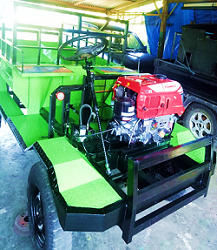Pembuatan Alat Angkut Tradisional Berbasis Bahan Bekas untuk Membantu Kelompok Tani di Lahan Gambut Kabupaten Pulang Pisau Making Traditional Transport Equipment Based on Used Material to Help Farmers' Groups in Peatlands, Pulang Pisau Regency
Main Article Content
Abstract
Oil palm plantations on peatlands have a high acidity level and have an unstable soil structure. In the rainy season, the land surface tends to be slippery and stick to vehicle footwear or tires. While in the dry season, the soil is dry, flammable, and dusty, especially if it is passed by a four-wheeled vehicle with a significant weight and size. Farmers transport the harvest of palm fruit using a small size conveyance, a type of “arco” capacity 50-70 kg, plastic drum capacity 40-50 kg, and peninsula capacity 30-40 kg. The process of transporting palm fruit from harvest to the mill takes a long time, potentially harming farmers due to “restan fruit” (palm oil is loose from the stem). The leading cause is the conveyance that is used in small volumes and is done by human labor. Palm fruit to stay fresh arrived at the processing plant with a duration of no more than 2 x 24 hours, if late farmers experience a loss of 10-15% because the weight of the scales is shrinking. The innovation of traditional conveyance capacity 500-750 kg based on used materials has been carried out using a special design that takes into account the carrying capacity, labor, road conditions, and timeliness so that the fruit does not become “restan.” Farmers are much helped both in terms of energy, process (time), transport volume, and can be operated on peatlands in both the rainy or dry season.
Downloads
Article Details
Authors who publish with this journal agree to the following terms:
- Any article on the copyright is retained by the author(s).
- Author grant the journal, right of first publication with the work simultaneously licensed under a Creative Commons Attribution License that allows others to share work with acknowledgment of the work authors and initial publications in this journal.
- Authors are able to enter into a separate, additional contractual arrangements for non-exclusive distribution of published articles of work (eg, post-institutional repository) or publish it in a book, with acknowledgment of its initial publication in this journal.
- Authors are permitted and encouraged to post their work online (e.g., in institutional repositories or on their websites) prior to and during the submission process, as can lead to productive exchanges, as well as earlier and greater citation of published work.
- The article and any associated published material is distributed under the Creative Commons Attribution-ShareAlike 4.0 International License
References
Darwis, V., Nurmanaf, A.R. 2004. Aktivitas Dan Sumber Pendapatan Petani Miskin Berlahan Sempit Di Daerah Sawah Tadah Hujan Dataran Rendah (Kasus: Dua Desa di Kabupaten Bojonegoro). SOCA: Jurnal Sosial Ekonomi Pertanian. 4(3):1-19.
Fadhil, R., Mustaqimah, Putra, B.S., Syafriandi, Lubis, A., Al-Qudri, Fikri, M. 2015. Evaluasi Kinerja Gerobak Sorong Bermesin Untuk Pengangkutan Tandan Buah Segar Kelapa Sawit (Elaeis guineensis jacq.). Agrotekno. 17(2):1-7.
Gunawan, R., Thamrin, J., Suhendar, E. 1998. Industrialisasi Kehutanan Dan Dampaknya Terhadap Masyarakat Adat: Kasus Kalimantan Timur. Bandung: Akatiga.
Hermanto, Swastika, D.K.S. 2011. Penguatan Kelompok Tani: Langkah Awal Peningkatan Kesejahteraan Petani. Analisis Kebijakan Pertanian. 9(4):371-390. http://dx.doi.org/10.21082/akp.v9n4.2011.371-390
Irawati, E., Yantu, M.R. 2015. Kinerja Kelompok Tani Dalam Menunjang Pendapatan Usahatani Padi Sawah Di Desa Sidera Kecamatan Sigi Biromaru Kabupaten Sigi. Agrotekbis : E-Jurnal Ilmu Pertanian. 3(2):206-211.
Kamuntuan, N., Ionda, V.Y., Tampongangoy, D.L. 2017. Pemberdayaan Kelompok Tani Di Desa Tolombukan Kecamatan Pasan Kabupaten Minahasa Tenggara. Jurnal Administrasi Publik. 3(46):1-11.
Pratama, B.P., Sayamar, E., Tety, E. 2016. Peran Kelompok Tani Dalam Meningkatkan Pendapatan Petani Swadaya Kelapa Sawit Di Desa Bukit Lingkar Kecamatan Batang Cenaku Kabupaten Indragiri Hulu. Jurnal Online Mahasiswa Fakultas Pertanian Universitas Riau. 3(2):1-12.
Pudjianto, B. 2006. Pemetaan Sosial di Kecamatan Sebangau Kuala, Kabupaten Pulang Pisau Provinsi Kalimantan Tengah. Jurnal Penelitian dan Pengembangan Kesejahteraan Sosial. 11(2):48-58.
Suharyanto, Rinaldy, J., Arya, N.N. 2016. Analisis Risiko Produksi Usahatani Padi Sawah di Provinsi Bali. AGRARIS: Journal of Agribusiness and Rural Development Research. 1(2):70-77. https://doi.org/10.18196/agr.1210
